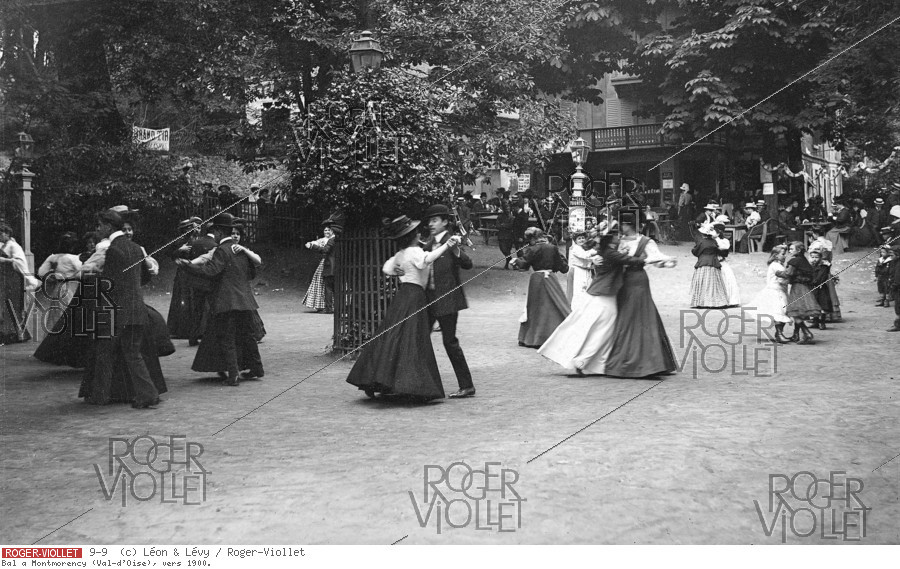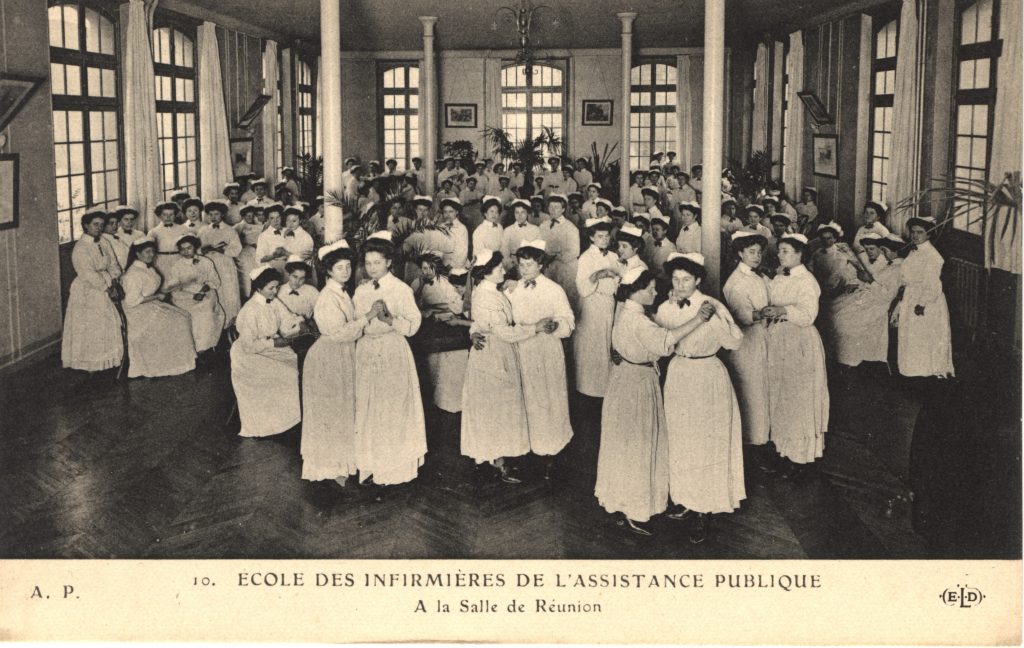A few months ago, I became hungry for archive pictures, as I wanted to know more about the “tradition” of men leading and women following. In history, qere there some women leading couple dances ? Was it allowed ? Frequent ? I started to explore online photo archives and museum’s collections, searching for pictures of women leading and men following, proof that some people were transgressing the gender rules of dancing. And, to my surprise, that was much easier than I anticipated.
Where did I find these archive pictures ?
There are plenty of historical photos on the internet, more or less documented, showing women and men dancing with people of the same sex. The source or the time where the picture was taken rarely being specified, I decided I wouldn’t take Google Images into account. So I decided to carry out my own research, in clearly identified collections, for example: the Library of Congress, the historical video collection of British Pathé, The Granger Collection, the Gallica fund of the National Library of France, the Roger Viollet fund, Alamy and Getty Images stocks, the Europeana archive bank…
I then searched broadly for couple dances (traditional balls, tango, waltz, ballroom) with clearly identifiable same-sex people dancing together. Finally, I focused only on couple dancing, excluding choreographed dances, rondes, quadrilles, bourrées and other “men’s” or “women’s” dances, or group dances where the alternation between men and women is often a prerequisite.
Finally, the last difficulty, I had to identify that the subjects were actually dancing together in a fairly clear way, because certain movements can be similar to dancing: a bow, posing for a photo, simply holding size, etc.
Women are leading everywhere, in every decade
My first observation is that it is not at all difficult to find images from all eras showing women who guide other women: dance classes, houses for young girls, balls… The reasons why these girls and women guides were undoubtedly diverse: to train, for lack of men… In the end, whatever the reasons, what I see is that it’s COMMON.
I believe it’s a rather “popular” practice. Most photos of high society balls or debutante balls are showing male-female couples. It is therefore outside, at the guinguette, at the July 14 ball or at the beach that we find the most photos of women dancing together.

Légende de la photo : “Waltz me around again, Willie”

1918 – Women celebrating the end of the war
New York Times Co / Getty images
1918 – Women In Uniform During The First World:
The Women’s Royal Naval Service, Osea Island, Essex
1925 – Bathing on the Wannseebeach: Dancing girls at the “Berliner Riviera”, Photograph, Around 1925 (Photo by Imagno/Getty Images)

By doing this research, I expected to find many more photos of women than of men dancing together for obvious reasons, the proximity of men being much more difficult to assume in public as one goes back in the past. On the other hand, I did not expect to find such a volume of archives presenting women who guide.
Hence this big question: if women have been guiding so frequently for more than 100 years, why the hell in 2023 do we still have this gendered distribution that is so binary and systematic: man = guide + woman = follow? Why weren’t people given the choice long time ago to experience both roles and choose which one they would like to have? (I have a personal theory based on male ego not to offend).
1932 – Cabaret in Montparnasse – Paris, France in 1932
(Photo by Keystone-France/Gamma-Keystone via Getty Images)
1939 – Two pairs of female jitterbug dancers at the World’s Fair, New York, 1939. (Photo by Max Peter Haas/Archive Photos/Getty Images)
6/19/1933 – Santa Monica,CA-Jazz band playing in the swimming pool at the Santa Monica Hotel.
Dancing in a swimmin pool in 1933… Candasa festival did not invent the thing
Some of these photos, I find them extraordinary, and I can’t help but think But why? How could this have happened and that there was precisely a person with a camera at that time? Like this photo of factory workers enjoying a swing dance, these soldiers’ wives with their incredible smiles, this “All Ladies” competition from 1943 judged by…the only man in the room, or these two ladies dancing the jive in the middle of the street in London, in front of a crowd of men?
1957 – A group playing and jiving in the street at a Fifties fair in Soho, London. (Photo by Evening Standard/Getty Images)
Sometimes, my ressources give a bit of context. This is the case, for example, of this incredible photo from the Los Angeles Public Library, where we see a couple of women and a couple of men (on the right) doing a jitterbug lift, literally with their legs around the size of their partner, in a town hall, in front of an audience of lawyers.

Digital collections of the Los Angeles Public Library
Around the same time, in 1937’ss Blackpool (England), the caption reads: “Holidaymakers dancing on Blackpool seafront. Humphrey Spender explained why Tom Harrisson wanted him to photograph Blackpool dancing in the book Worktown People: “What fascinated Tom there was all the girls dancing together.”
Europeana.eu
Europeana.eu
1953 – An exuberant group of ladies dance together on the deck of the Royal Sovereign – a pleasure steamer taking passengers on a trip up the Thames for a day out in Southend, July 1953. Original publication: Picture Post – 6611 – Picture Post Takes A River Trip To Southend – pub. 1st August 1953 (Photo by Bert Hardy/Picture Post/Hulton Archive/Getty Images)
1957 – Female ICI employees enjoy a dance, South Yorkshire.
A couple of girls from the ICI Detonator factory in Denaby Main (near Doncaster) take a break from producing munitions to dance a jive whilst the other girls from the factory look on.
(Photo by Paul Walters Worldwide Photography Ltd./Heritage Images/Getty Images)
1959 – Russian women dancing
Caught up in the excitement of the holiday, two Russian women whirl around in a dance to the rhythm of the parade music. Like Cinderella, Red Square leads a colorless, almost drab existence except for its ay of merry making.
People unable to learn both roles, this great myth
Even today, when I go to a dance class or at a party, I frequently hear “you do both roles? I wouldn’t be able to do it“. But whether it’s me or anyone, I would like us to take a few moments to look at these images together and realise that we have collectively been able to do this for a long time.
Men dancing together
So of course, we’re not going to talk only about women, because men can dance together too. And if there are relatively few visual traces, without too much surprise, these are times when the men outnumbered their female partners, especially in the army.

Photograph shows sailors dancing on the U.S.S. Recruit, a fake battleship built in Union Square, New York City by the Navy to recruit seamen and sell Liberty Bonds.

Library of Congress :Weekly dances are held at the Gare St. Lazare, Paris, and are most popular affairs. Soldiers and sailors look forward to these dances where real American girls are there to dance with them February 1919

1974 – Two men do the jitterbug on the dance floor of Le Jardin, New York, New York, March 15, 1974. (Photo by Allan Tannenbaum/Getty Images)
Edit : Addition of this amazing short film from1895‘s men dancing waltz. Experimental sound film made for Edison’s kinetophone — a combination of the kinetoscope and phonograph — but apparently never distributed. This LC copy is silent. Features two men dancing to a violinist. Source : Library of Congress
It is obvious that I am not the only one to have considered the question of the representation of dance couples free of gender assignment, and in particular queer couples. A number of associations have put together their own photographic collection, and collection collectives exist, like The Queer tango image archive, which inspired me to begin my research.
Finally, it should be noted that I post my discoveries as I go along in a nice Pinterest board that includes much more pictures than those presented here. It is likely that I will continue my research for a long time, because chilling on the internet has a strangely calming effect on me, especially looking at archival photos of happy times now long gone. Dear readers, keep in mind that we are links in a very long chain, and do not hesitate to document your practices so that they serve as an example in the future!
Oh no, this is Germany in 1966
Deutsche Fotothek – Europeana
Cover pictures : The library of Congress. Delano, Jack, 1914-1997, photographer. Date : Oct.1940
The evening program after the barrel rolling contest consisted of dancing in the street (plenty of jitterbugging). Presque Isle, Maine.



